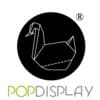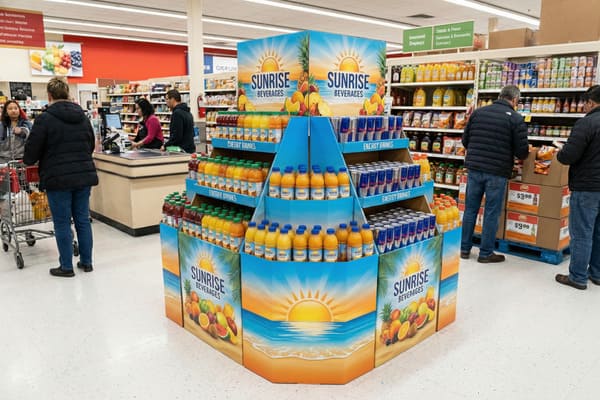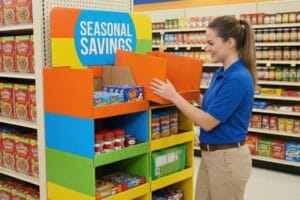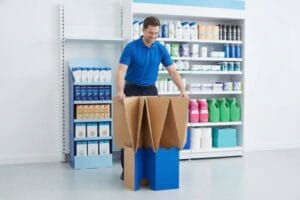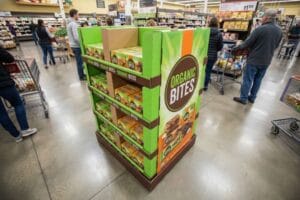Are you worried that generic shelving makes your premium products look ordinary in retail stores? You need a display solution that mirrors your brand’s identity and captures customer attention immediately.
Yes, floor POP displays offer extensive customization options. You can tailor the structural shape, size, and full-color graphics to align perfectly with your brand identity. Manufacturers use digital and offset printing to match specific Pantone colors, ensuring your display seamlessly integrates with your marketing strategy.

Understanding how customization works is the first step, but we also need to clarify the terminology used in the industry to ensure you get exactly what you need.
What is the difference between POS and POP displays?
Many retailers and buyers confuse these two terms, which can lead to miscommunication about design goals. Let’s clear up the confusion so you can place your budget where it counts.
POP (Point of Purchase) refers to displays placed anywhere in the retail store where customers make decisions, like aisles. POS (Point of Sale) specifically targets the checkout area where the actual transaction happens. POP drives product awareness, while POS focuses on encouraging last-minute impulse buys.
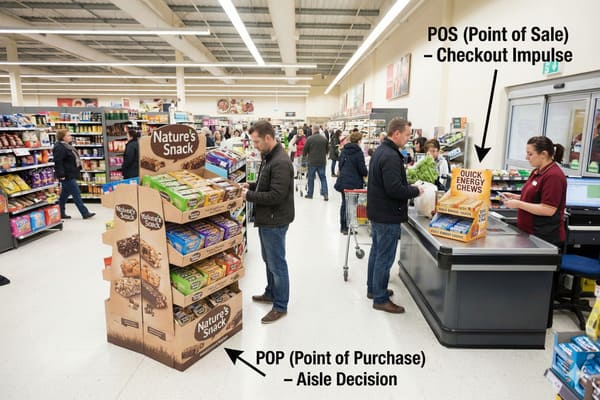
The Strategic Anatomy of Retail Zones
To truly understand the difference between Point of Purchase (POP)1 and Point of Sale (POS)2, we must look at the psychology of the shopper and the physical layout of the retail environment. This is not just about acronyms; it is about where your customer is in their buying journey. POP displays are the heavy lifters of the retail world. They are located in the main aisles or "action alleys" of stores like Walmart or specialized outdoor shops. Their primary job is to interrupt the shopper’s path. When I work with clients selling larger items, like hunting gear or electronics, we focus on POP because the customer is in the discovery phase. They are comparing options, and a large floor display gives us the real estate to explain features and benefits.
On the other hand, POS displays serve a completely different function. These are the smaller units you see right next to the cash register. The shopper has already finished their main shopping trip and is waiting to pay. The mindset here is not discovery; it is impulse. Products here need to be low-cost and require zero thought, like batteries, candy, or small accessories. From a manufacturing perspective, the structural requirements are also different. POP displays often need to hold significant weight (often 20kg to 50kg per shelf) and require sturdy corrugated board, such as double-wall BC-flute material. POS displays are smaller, often sitting on a counter, and can be made from lighter E-flute or B-flute materials since they hold less weight. Confusing these two leads to weak structures in the aisles or oversized units cluttering the checkout counter.
| Feature | Point of Purchase (POP)3 | Point of Sale (POS)4 |
|---|---|---|
| Primary Location | Main aisles, endcaps, store entrance | Checkout counters, cash wrap areas |
| Shopper Mindset | Discovery, Comparison, Evaluation | Impulse, Add-on, "Last Chance" |
| Typical Size | Large Floor Stands, Pallet Displays | Small Countertop Units, Clip Strips |
| Material Grade | Heavy-duty (BC-flute, EB-flute) | Light-duty (E-flute, B-flute) |
| Product Type | Core products, Bulk items, New Launches | Accessories, Gum, Batteries |
I consistently advise my clients to define their sales goal before we start the design process. If you want to move high-value inventory like crossbows or tools, we focus on a robust POP floor structure. My team uses 3D rendering to show you exactly how the unit will look in a wide aisle versus a crowded checkout counter, ensuring we pick the right vehicle for your product.
How do you ensure that promotional displays are set up correctly?
A collapsed display in a busy store is a branding nightmare and a safety hazard. You need assurance that your units will stand tall, look professional, and remain stable.
Ensuring correct setup requires pre-assembled shipping or intuitive design with clear instructions. Manufacturers use "flat-pack" designs with numbered tabs or pop-up mechanisms to simplify assembly. Rigorous prototyping and load-bearing tests during production guarantee the structure is stable and easy for retail staff to deploy.
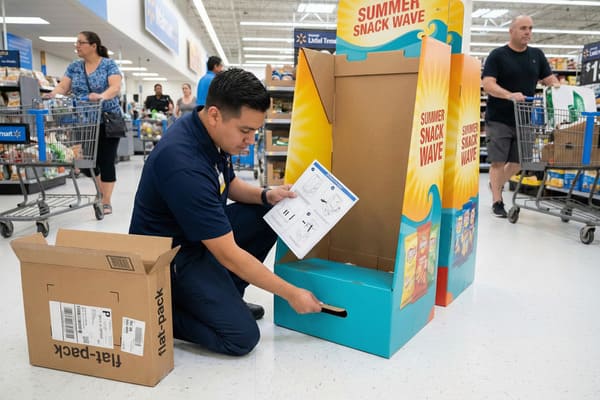
Structural Integrity and Assembly Logic
The success of a promotional display is often determined before it ever leaves the factory. One of the biggest challenges in this industry is the "10-minute rule5." If a retail store employee cannot assemble your display within ten minutes, they will likely throw it away or set it up incorrectly. This is a massive loss for your brand. To prevent this, the structural design must be intuitive. We move away from complex origami-style folds and towards "snap-lock" bottoms and pre-glued parts. For example, a standard floor display should have a base that pops open automatically. This reduces the cognitive load on the person setting it up.
Beyond the ease of assembly, we must consider the durability of the materials used. A display that leans or sags sends a message of low quality. This is where material selection becomes critical. We analyze the humidity levels of the target region and the duration of the promotion. For a three-month campaign in a humid region, standard cardboard will absorb moisture and collapse. We must use reinforced corrugated board6 with water-resistant coatings or varnish. Furthermore, compliance with retailer standards is non-negotiable. Major retailers like Costco and Target have strict guidebooks regarding display dimensions and assembly. If your display arrives and takes too much effort to manage, they may fine you or refuse the shipment. We simulate the setup process in our factory to identify any potential frustration points. We number the tabs on the cardboard (e.g., "Fold Tab A into Slot A") to make the process idiot-proof.
| Assembly Type | Description | Setup Time | Cost Impact |
|---|---|---|---|
| Flat-Pack7 | Ships flat, requires full assembly in-store | 10-15 Mins | Lowest Shipping Cost |
| Semi-Assembled | Base is glued; only headers/shelves need setup | 3-5 Mins | Moderate Shipping Cost |
| Pre-Filled (Co-pack)8 | Ships with product already inside | 0 Mins (Instant) | Higher Logistics Cost |
| Pop-Up Design | Internal elastic bands or glues automate shape | 1-2 Mins | Higher Production Cost |
I always insist on creating a physical prototype and recording a video of my team assembling it before we approve mass production. I personally check that the internal supports can handle the weight of your specific products, and if the assembly takes more than five minutes, I send the design back to my engineers for simplification.
What is pop display in marketing?
Is your product getting lost on the crowded shelf among dozens of competitors? You need a "silent salesman" that grabs attention and communicates value instantly without human intervention.
In marketing, a POP display is a strategic tool used to highlight products separate from standard shelving. It disrupts the shopper’s journey, increases brand visibility, and educates consumers through graphics and structural design. It effectively bridges the gap between mass advertising and the final purchasing decision.
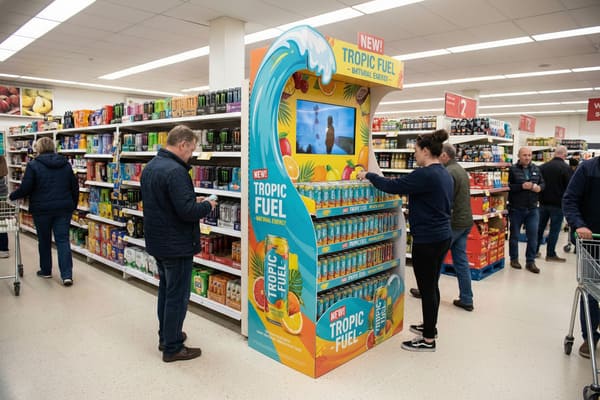
The Silent Salesman and Brand Consistency
In the context of marketing, a POP display is far more than just a cardboard box; it is the physical manifestation of your brand’s voice in the retail environment. We often call it the "Silent Salesman." When you run TV ads or social media campaigns, you generate interest. However, the POP display is what captures that interest at the crucial moment of purchase. It relies heavily on the AIDA model9: Attention, Interest, Desire, and Action. The structure must first grab Attention through size or unique shape. Then, the graphics must generate Interest and Desire.
This is where printing quality becomes the most vital technical aspect. If your brand color is a specific shade of "Barnett Red," the display must match that exactly. A washed-out red makes the product look old or fake. We utilize litho-lamination for high-quantity runs to ensure magazine-quality glossy finishes, or high-end digital printing for shorter runs. This ensures that the images of your product are sharp and the colors are vibrant. Another marketing aspect is the "billboard effect." A floor display offers large side panels that standard retail shelves do not. You can use this space to tell a story, list technical specifications, or show the product in use. For complex products like hunting gear or electronics, this educational space is invaluable. It answers the customer’s questions so they feel confident putting the item in their cart. The display effectively isolates your product from competitors, creating a mini-brand environment within a larger store.
| Marketing Function | Technical Execution | Outcome |
|---|---|---|
| Brand Recognition10 | PMS Color Matching & High-Gloss Finish | Shopper instantly identifies the brand |
| Education | Large Side Panels & Header Cards | Explains complex product features |
| Differentiation | Custom Die-cut Shapes (non-rectangular) | Stands out against boring metal shelves |
| Impulse Drive11 | Strategic Placement & "Grab-and-Go" Bins | Increases unplanned purchase volume |
We use advanced color management systems in our factory to ensure your brand colors remain consistent across every batch. I understand that for a brand owner, color inconsistency is a deal-breaker, so we provide high-resolution printed proofs for you to sign off on before we run the full production line.
Which is an example of a pop point-of-purchase display?
Visualizing the right format for your product can be difficult with so many options available. Seeing concrete examples helps you choose the best structure for your specific campaign needs.
Common examples include floor stands, pallet displays, and dump bins found in grocery aisles. A pallet display (full pallet skirt) creates a massive brand block in warehouse clubs like Costco. Floor stands with shelves allow organized presentation of multiple SKUs, while dump bins are ideal for loose, discounted items.
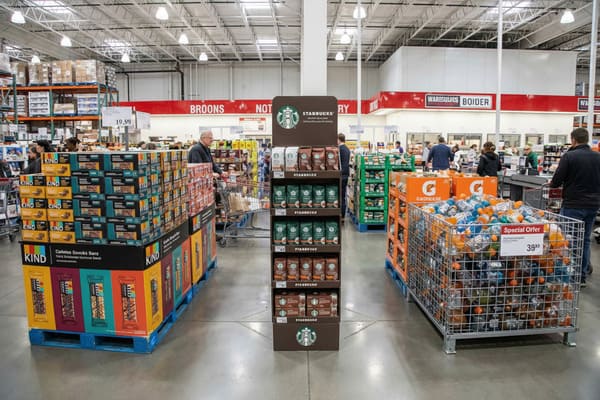
Analyzing Display Formats for Heavy Inventory
When we discuss examples of POP displays, we must look at the specific structural engineering required for different product categories. For clients in the outdoor or hardware industries, the "Quarter Pallet12" or "Full Pallet" display is a classic example. These are designed to fit directly onto standard wooden shipping pallets. They are massive, often holding hundreds of pounds of merchandise. The engineering here focuses on vertical compression strength. We use heavy-duty corrugated board, often double-wall or even triple-wall, to ensure the bottom layers do not crush under the weight of the top layers during transport and display.
Another common example is the "Power Wing13" or "Sidekick" display. These are the narrow units you see hanging off the side of an end-cap in a supermarket. They are excellent for cross-merchandising. For instance, if you sell arrowheads, a sidekick display hanging next to the main bow hunting aisle is a perfect placement. However, these require careful design of the hanging clips and hooks to ensure they don’t fall off when a customer grabs an item. A third example is the standard "Floor Stand with Shelves." This is the workhorse of the industry. It usually has a header card on top and 3 to 4 shelves. The critical factor here is the "weight per shelf" rating. If you are displaying heavy tools, we might add metal support bars under the cardboard shelves, which are invisible to the customer but add immense strength. This hybrid material approach allows us to maintain the low cost of cardboard while achieving the strength of a permanent fixture.
| Display Type | Best Use Case | Typical Load Capacity | Key Structural Feature |
|---|---|---|---|
| Pallet Display14 | Warehouse clubs (Costco), Bulk items | 200kg – 500kg+ | Fits standard 40×48" pallet |
| Floor Stand15 | Supermarkets, multiple SKU arrangement | 10kg – 25kg per shelf | Reinforced shelf lips & dividers |
| Dump Bin | Discount items, loose products | 15kg – 30kg total | False bottom to keep items visible |
| Sidekick / Wing | Accessories, cross-selling on endcaps | 3kg – 8kg total | Plastic hooks or wire hangers |
| Counter Unit | Small items at checkout (POS) | 1kg – 5kg total | Compact footprint, easel back |
I treat every new project as an engineering challenge first and a design challenge second. We perform rigorous load-bearing tests in our facility where we place weights on the shelves for 24 hours to measure deflection. I will not let a display leave my factory unless I am confident it can hold your product safely.
Conclusion
Customized cardboard displays are a powerful tool to enhance brand visibility and drive sales in retail environments. By understanding the differences between POS and POP, ensuring correct setup, and leveraging structural design, you can create effective marketing solutions.
Understanding POP is crucial for effective retail strategies, as it influences shopper behavior and sales. ↩
Exploring POS helps retailers optimize checkout experiences and boost impulse purchases effectively. ↩
Explore this link to understand how POP displays can enhance product visibility and boost sales. ↩
Discover how POS technology streamlines transactions and enhances customer satisfaction in retail. ↩
Understanding the 10-minute rule can help you design displays that are easy to assemble, reducing waste and improving brand perception. ↩
Exploring the advantages of reinforced corrugated board can enhance your display’s durability and effectiveness in various environments. ↩
Exploring this link will provide insights into the advantages of Flat-Pack furniture, including cost savings and convenience. ↩
This resource will help you understand the benefits of Pre-Filled (Co-pack) packaging, enhancing efficiency and reducing handling time. ↩
Exploring the AIDA model will help you grasp how to attract and convert customers through effective marketing techniques. ↩
Explore this link to discover proven strategies that can enhance your brand’s visibility and recognition in the market. ↩
Learn how impulse drive marketing techniques can significantly boost your sales and encourage unplanned purchases. ↩
Explore how Quarter Pallet displays can optimize your retail space and enhance product visibility. ↩
Learn how Power Wing displays can boost sales through strategic product placement and visibility. ↩
Explore this link to understand how Pallet Displays can enhance product visibility and sales in retail environments. ↩
Discover insights on how Floor Stands can optimize space and showcase multiple SKUs effectively in supermarkets. ↩
